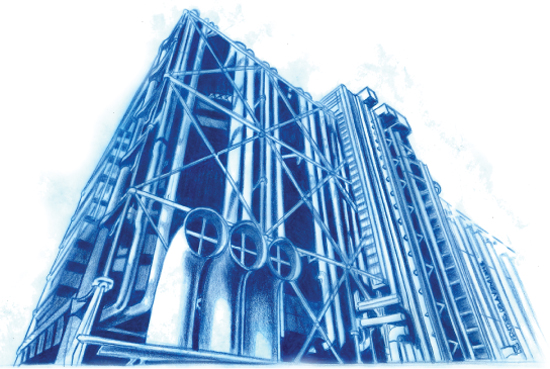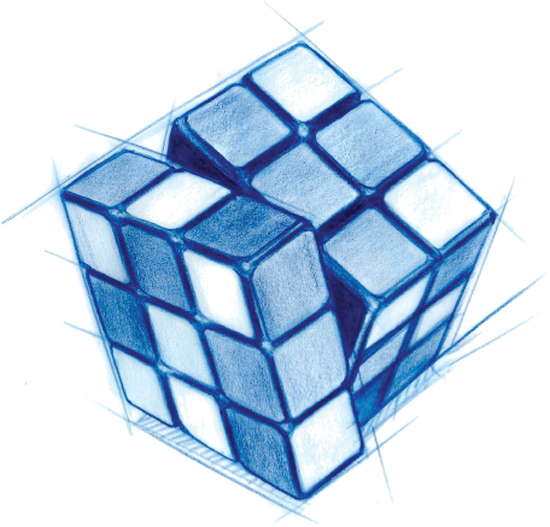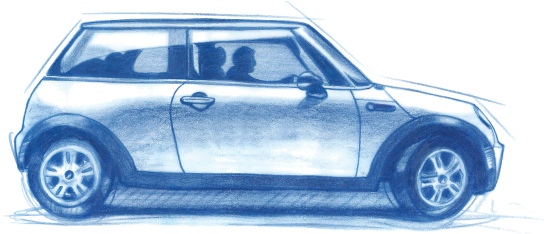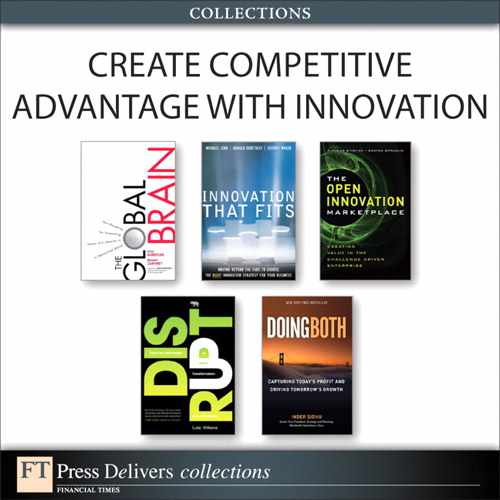Chapter 1: Crafting a Disruptive Hypothesis: Be Wrong at the Start to Be Right at the End

“What would happen if we sold socks in sets of three, where none of them match?”
“I love tackling lazy industries.”
—Richard Branson1
It all starts with a wild question: In Hollywood, it might be, “What would happen if a shark swam into a beach resort and attacked a swimmer?” Jaws. In architecture, someone must have wondered, “What would happen if we put the plumbing, electrical services, and air vents on the outside of a building instead of the inside?” Pompidou Center, Paris. In fashion, “What would happen if we sold socks in sets of three, where none of them match?” Little Miss Matched. In the video rental business, “What would happen if we didn’t charge late fees?” Netflix.
Each of these innovations—which were revolutionary in their time—began with a disruptive hypothesis, a seemingly crazy way to fill in the blank part of the question, “I wonder what would happen if we….” It would have been easy to go for incremental tweaks, such as “…if we changed the color,” or “…if we added a new feature,” or “…if we moved our production overseas.” But, disruptive hypotheses go way, way beyond that.
A disruptive hypothesis is an intentionally unreasonable statement that gets your thinking flowing in a different direction. It’s kind of like the evolutionary biology theory of “punctuated equilibrium,” which states that evolution proceeds slowly and every once in a while is interrupted by sudden change. Disruptive hypotheses are designed to upset your comfortable, business equilibrium and bring about an accelerated change in your own thinking.
Contrast this with the more traditional definition of “hypothesis,” which is a best-guess explanation that’s based on a set of facts and can be tested by further investigation. For example, you try to make a call on your cell phone and all you get is a blank screen. Based on that fact (the phone won’t power up), you come up with a hypothesis: The battery may be dead, so if I charge the battery, the phone should work. You then test that hypothesis by charging the battery. If your hypothesis was correct, you should be able to make calls. If the phone is still dead, you’ll need to formulate a new hypothesis and test it.
With a disruptive hypothesis, however, you don’t make a reasonable prediction. (If I charge the battery, the phone will work.) Instead, you make an unreasonable provocation. (What if a cell phone didn’t need a battery at all?) The difference between prediction and provocation, to paraphrase George Bernard Shaw’s famous line, is the difference between “seeing things as they are and asking, ‘Why?,’ or dreaming things as they never were and asking, ‘What if?’”2
In our fast-changing world, when business certainties are no longer certain, the ability to imagine things as they never were and ask, “What if?,” is an essential part of every executive’s skill set. So, the goal in this chapter is to start generating hypotheses that will enable you to radically reinterpret topics that everyone else in your industry has probably taken for granted.

“What would happen if we put the plumbing, electrical services, and air vents on the outside of a building instead of the inside?” Pompidou Center, Paris.
Harvard Professor Niall Ferguson has a genius for this form of provocation. Named by Time magazine as one of the planet’s 100 Most Influential People, his radical theories force readers to refine their own thinking. “It’s not about being a contrarian for its own sake,” says Ferguson, “it’s about being willing to test all hypotheses.”3 On the abolishment of slavery in Britain, for example, “It used to be argued that slavery was abolished simply because it had ceased to be profitable, but all the evidence points the other way; in fact, it was abolished despite the fact that it was still profitable. What we need to understand, then, is a collective change of heart.”4 Ferguson also takes a swipe at the conventional wisdom surrounding aspects of World War I. “The key to the Allies’ victory was not an improvement in their ability to kill the enemy,” Ferguson argues, “but rather a sudden increase in the willingness of German soldiers to surrender.”5
As we go through the process of doing a little disrupting of our own, I want you to keep in mind the three following questions:
1. What do you want to disrupt?
2. What are the clichés?
3. What are your disruptive hypotheses?
What Do You Want to Disrupt?
As mentioned in the Introduction, one of the major hurdles facing today’s executives and business leaders is how to meaningfully differentiate themselves from everyone else who’s operating in the same space. To do that requires that you define the situation in the industry, segment, or category that you want to challenge. And by “situation,” I mean the broad view from 10,000 feet. Here’s what this might look like:
• This is an area in which everyone seems to be stuck in the same predicament and nothing has changed in a very long time.
• This is an area where profit performance is average—it really should be more successful than it is.
• This is a category where growth is slow and everything seems the same.
Once you have a situation to focus on, describe it in one sentence: “How can we disrupt the competitive landscape of [insert your situation] by delivering an unexpected solution?”
Whether you choose to think about an industry, segment, or category is up to you and your business needs. For example, if you owned a boutique hotel in San Francisco, you might describe your situation in one or more of the following ways:
• How can we disrupt the competitive landscape of the Travel & Leisure industry by delivering an unexpected solution?
• How can we disrupt the competitive landscape of the Hotel segment by delivering an unexpected solution?
• How can we disrupt the competitive landscape of the Luxury Hotel category by delivering an unexpected solution?
That’s it. The important thing is that the high-level situation you choose is just that—high-level. It’s essential that you resist the natural urge to start thinking in terms of specific “problems.” I know this runs counter to conventional innovation-and business-planning approaches, where people are conditioned to think only in terms of finding solutions. But, let’s put it this way: If you define your situation as, “How can we increase the price of our hotel rooms?,” you’ve effectively confined your range of possibilities to only issues having to do with raising your room rates. It’s possible that you could end up with a completely new solution to a very specific problem, but at this stage, such a narrow focus will greatly limit your options later.
What Are the Clichés?
Now that you’ve defined your situation, the next step is to identify the assumptions that seem to influence the way insiders (and often outsiders) think about an industry, segment, or category. In other words, what are the clichés—the widespread, hackneyed beliefs that govern the way people think about and do business in a particular space. If you pay attention, you’ll notice that clichés are everywhere. (You’ll also notice that, almost by definition, they’ve lost their ingenuity and impact.) In their book Funky Business, authors Jonas Ridderstrale and Kjell Nordström refer to the proliferation of business clichés as the surplus society: “A surplus of similar companies, employing similar people, with similar educational backgrounds, coming up with similar ideas, producing similar things, with similar prices and similar quality.”6
Director Quentin Tarantino cites the film Patriot Games as a typical Hollywood action/drama that uses the conventional “the-hero-is-not-a-murderer” cliché: The reluctant hero, Jack Ryan (played by Harrison Ford) has “every reason to gouge out the eyes and cut off the head of the man who terrorized and tried to kill him, his wife, his children,” says Tarantino. But how does the villain die? “He falls off the boat and hits his head on the motor. So it’s accidental that the villain gets killed. The important thing is that the hero is not a murderer.” Tarantino denies this cliché. In his movies, the hero is often a murderer (Uma Thurman’s character in Kill Bill, for example). “I want people to take revenge when revenge comes.”7
Consider the multi-billion dollar video gaming industry. Video consoles, which are a big chunk of that market, were dominated by two giants: Sony with its Playstation and Microsoft with its Xbox. Both were driven by several clichés. First, that the world is split into “gamers” and “nongamers.” Second, that gamers mostly care about faster chips and more realistic graphics. Third, game consoles are expensive. And fourth, that people play video games sitting down, barely moving anything but their fingers.
Then, along comes Nintendo, a distant third player, which turned the gaming industry’s clichés on their head. Nintendo’s Wii is relatively cheap, has no hard drive, no DVD, has weak connectivity, and comparatively low processor speed. But, within weeks of its launch, Wii became a hit with consumers, thanks to its innovative motion controller, which integrates players’ movements directly into the game.
With the Wii, you can play tennis, baseball, golf, and even bowling. You can sword fight and box, too. Nintendo opened up the console world to a huge demographic of people who never considered themselves gamers. As journalist Joshua Cooper Ramo observes, the Wii, “demolished the wall between real and virtual, eroded the idea that world was split into ‘gamers’ and ‘nongamers,’ and forced the competition to completely rethink the whole idea of a game… Wii killed the idea that a video game was something you played without breaking a sweat.”8
With the Wii, Nintendo turned the gaming industry’s clichés on their head.
Searching for Clichés
Just being told, “Okay, get out there and find those clichés,” can be extremely daunting. So, here are a few tips that will help you jump-start the process.
Start by getting online and identifying a handful of direct competitors in the industry, segment, or category you’re focused on. If there are dozens or hundreds of competitors, you can’t possibly consider all of them. Instead, group together those with similar characteristics (such as size and resources), strengths (such as brand name, distribution), and strategies (such as high quality). 9 Select one or two competitors in each group that are pretty representative of the group as a whole. A total of three to six competitors are the ideal number to work with.
Now, do a little research on each competitor and make a list of the clichés that keep everyone doing the same thing, competing the same way, or operating with the same set of assumptions. The quickest and most efficient way to do this is to explore company websites, examine their advertising, and read what people are saying about the companies and their products on blogs and other social media platforms (such as Twitter, Facebook, and Amazon). It shouldn’t take you more than two to three hours to get a good feel for the competitive landscape. If you have more time, make your research efforts as experiential as possible—order one of a company’s products online or sign up for their service. If they have a brick-and-mortar presence, sample those products or services in person.
Keep your research activities quick and informal, intuitive and qualitative. And list any clichés you think are relevant. But to keep you from drowning in a sea of information, consider using the following three filters:
• Product clichés: What are the cliché features and benefits? What are the cliché product attributes that are advertised (convenience and reliability, for example)? Where are the cliché areas where the product competes (typical customers, typical geographies, and typical market size)? In the soft-drink industry, for example, some of the product clichés are as follows: Soda is inexpensive, it tastes sweet, and it’s advertised as aspirational. (For example, if you want to be like [fill in the name of your favorite celebrity spokesperson], you have to drink Mountain Dew.)
• Interaction clichés: What are the cliché steps a customer experiences when buying and consuming their products and services? Is the interaction face-to-face? How frequently do customers purchase or use? In the rental car business, for instance, the prevailing interaction clichés include the following: face-to-face interaction with a service agent, completing a lot of paperwork, and renting vehicles by the day.
• Pricing clichés: What are the typical ways companies price their products and services and charge customers? Are they packaging products and services together or pricing them individually? Are they charging the customer directly or through a retail partner? Are they offering discounts or other incentives? In the magazine industry, the dominant pricing paradigm is a subscription-sale model, whereby the magazines offer a hefty discount (often more than 50 percent off the cover price) for annual subscriptions.
If you’re searching for clichés with a team—or even if you’re doing it alone—all you need to come up with is three or four for each of the filters just listed. This will give you a list of 9 to 12 clichés to work with as you develop your hypotheses. You’re not trying to be comprehensive or get everyone to agree on what the clichés are. The point is to get those tired truisms on the table so you can confront them later.
Often, the more established and obvious the cliché, the greater the impact when it’s challenged. If we eat at a restaurant, for example, we expect to select what we eat from a menu we review when we arrive. If we buy socks, we expect they’ll be sold in pairs that match. We don’t consciously think about these things because “that’s the way it has always been.” This is the paradox of identifying clichés—the most obvious and seemingly natural assumptions are the easiest to ignore. But, recognized or not, they still exert a powerful influence.
What Are Your Disruptive Hypotheses?
Now that you have a list of the clichés that are influencing the business situation you’re focused on, your next goal is to start provoking the status quo. To do that, you’ll take those clichés and twist them like a Rubik’s cube and look at them from the inside out, upside down, backward, and forward. You’re trying to find a way to rearrange the pieces, which in turn will provoke a different way of looking at the situation. Specifically, you’re looking for something (or things) that you could scale up or scale down, move in the opposite direction, or completely do without.10 Let’s take a closer look.

Take the clichés and twist them like a Rubik’s cube.
What Can You Invert?
In order for you to start moving in a new direction, you need to kick hard against what’s already there. There are usually a number of different ways to inverse a given situation. If there’s an action, look at the opposite action. If something is happening over time, run the time scale backward. If there’s a one-way relationship between two parties, try changing the direction 180 degrees. As we saw with the soft-drink industry, some of the clichés are
• Soda is inexpensive.
• It tastes good.
• It’s advertised as aspirational.
Inverting “soda is inexpensive,” gives you “soda is expensive,” and reversing “tastes good” gives you “tastes terrible,” both of which sound completely ridiculous. But, you can’t break the clichés without going through this step, which is exactly what Red Bull did. It placed absolutely no importance on taste; the product is double the price of Coca-Cola. And Red Bull dispensed with marketing aspirational images. The message was that Red Bull may not necessarily make you feel happy, but it’ll definitely give you a shot of energy when you need it.
Designer Tibor Kalman famously produced a series of deliberate cliché inversions designed to draw attention to multiculturalism and global awareness for Colors magazine. The Spring 1993 issue created an international stir on the topic of race by publishing full-page photos of the face of Queen Elizabeth II of Great Britain altered to look like a black woman, Pope John Paul II as an Asian, and filmmaker Spike Lee as a white man. That issue propelled Colors to international fame. “I’m always trying to turn things upside down and see if they look any better,”11 Kalman was fond of saying.
As both the Red Bull and Colors stories illustrate, inversions sometimes lead to significant breakthroughs.
What Can You Deny?
The denial method works by completely dumping key aspects of a cliché. Back to our rental car example for a minute, where the prevailing industry clichés include
• See the customer.
• Complete a lot of paperwork.
• Rent by the day.
What would happen if you no longer needed to see the customer, you got rid of the paperwork, and you started renting by the hour? Well, you’d end up with something very much like Zipcar, where there’s no waiting in line, no papers to fill out, and no pressure to upgrade or add 27 different kinds of insurance. In fact, there’s no face-to-face interaction at all. Customers apply to become members (or “zipsters”) and they reserve vehicles online. The disruption?
• Don’t see the customer.
• No paperwork.
• Rent by the hour.

With Zipcar, members pay an annual fee and then rent a car by the hour on a pay-as-you-go basis.
Many clichés are still around for no other reason than “we’ve always done it this way.” Remember The Cosby Show? How about Full House, Perfect Strangers, and Family Matters? In the 1980s and early 1990s, the entire television sitcom lineup operated according to what the industry referred to as the “hugging and learning rule.” Whatever tension developed during the first part of the show would be resolved at the end with all the main characters a little closer and a little wiser. Then, a show came along and started playing by a new rule: “no hugging, no learning.” No matter how much trouble the characters got into, they never learned from their mistakes, and they never ended with a wholesome message. It was a breath of fresh air in a stale category, and it became one of the most successful sitcoms of all time: Seinfeld.
What Can You Scale?
Each of us has a well-trained and highly developed sense of the natural size and proportions of the world around us. So, when items in a given situation are out of proportion with each other, it comes as a shock and immediately grabs our attention. The advertising industry has successfully used this technique for decades to get us to pay attention to their ads.
But, when it comes to generating disruptive hypotheses, you’re not exaggerating the scale simply to manipulate other peoples’ attention. Instead, you’re using the shock value to disrupt your own perception so you can look at the situation in a new way. What is scarce that could be made abundant? What is abundant that could be made scarce? What is expensive that could be free?
As I mentioned earlier, the pricing cliché in the magazine industry is a subscription-sale model, where publishers offer a significant discount for annual subscriptions. Typically, buying a subscription is 50 percent less than buying from a newsstand. Then, along comes a startup lifestyle magazine called Monocle, and instead of the traditional subscription-sale model, it created a subscription-premium model. The disruption? “Buying an annual subscription is 50 percent more than the cost of buying from a newsstand.”
That high-priced subscription also gets you exclusive access to premium website content, signature products, social events, books, and audio programs. In its first year, the magazine’s circulation was already 150,000, and it’s currently sold in more than 50 countries.12
Instead of the traditional subscription-sale model, Monocle created a subscription-premium model.
The Story of Little Miss Matched
There are all sorts of examples of companies that have been launched on the strength of their disruptive thinking. But one of my all-time favorites is Little Miss Matched. Jonah Staw, the co-founder and CEO of Little Miss Matched, used to work with me at frog design and is a poster boy for the kind of disruptive thinking that I espouse in this book. The company he co-founded with two other friends is a great example of how paying attention to the non-obvious and the seemingly mundane can lead directly to discovering areas where disruptive thinking can have an impact. At the end of each chapter, I’ll briefly describe how the story of Little Miss Matched dovetails with the process you’re reading about.
Think Outside the Socks! The Disruptive Hypothesis
Jonah was having dinner with some friends in a trendy restaurant in San Francisco when the discussion turned to what he calls “disruptive business ventures.” Suggestions were flying left and right, and at one point, someone asked, “How crazy would it be if some company started selling socks that didn’t match?” Everyone thought it was a terrible idea—not particularly practical, certainly not useful, and difficult to own—and they moved on. Everyone, that is, except Jonah, who couldn’t get the idea of mismatched socks out of his head. In his view, the sock category was lazy and boring; we’re still buying and wearing socks the same way we have for decades. And, how many times have you lost one sock and had to toss the matching one—how much of a pain is that? It was a category of clichés ripe for disruption.
Then, on a vacation trip to Vietnam, Jonah made an important observation that convinced him that this disruptive hypothesis was worth experimenting with. He and his wife had visited a town that was known for clothing manufacturing. Just for fun, Jonah designed a jacket for his wife and got a beautifully made, finished product back in two days for about $15. Clearly, the apparel industry was far more accessible and had far lower barriers to entry than, say, consumer electronics, where it would cost hundreds of thousands of dollars to get a working sample of an idea. He returned to the U.S. eager to discover who would be interested in wearing mismatched socks.
We’ll talk more about how this disruptive hypothesis eventually became a reality as we move through the rest of this book.
Your goal is to craft three disruptive “what if?” hypotheses for your situation: one inversion, one denial, and one exaggeration of scale.
Let’s look at how this would apply to creating disruptive hypotheses for a new restaurant venture. As Nassim Nicholas Taleb, author of The Black Swan: The Impact of the Highly Improbable, explains:
Think about the “secret recipe” to making a killing in the restaurant business. If it were known and obvious, then somebody next door would have already come up with the idea and it would have become generic. The next killing in the restaurant industry needs to be an idea that is not easily conceived of by the current population of restaurateurs. It has to be at some distance from expectations. The more unexpected the success of a venture, the smaller the number of competitors, and the more successful the entrepreneur who implements the idea.13
Here’s how you kick-start the process of creating something “not easily conceived of by the current population of restaurateurs.”
• Cliché: Restaurants provide customers with a menu when they arrive (interaction).
• Hypothesis: What if a restaurant provided customers with a menu only when they leave?
• Cliché: Customers pay for food and service (price).
• Hypothesis: What if customers were not charged for food and service?
• Cliché: Restaurants offer a three-course meal (product).
• Hypothesis: What if a restaurant offered a 30-course meal?
Remember, this exercise is designed to challenge your established way of looking at an industry, segment, or category.
The general rule is that the bolder your hypotheses, the fresher the perspective they offer. So, don’t skip this step and don’t worry if your “what if’s” seem completely ridiculous. After all, at first glance, a restaurant that doesn’t charge for food and service, offers a 30-course meal, and provides customers with a menu only when they leave, seems, well…absurd!
That is, until you eat at El Bulli–rated the best restaurant in the world a record four times (2002, 2006, 2007, and 2008). Founded by Ferran Adria–the chef considered to be the best in the world–no other restaurant does what El Bulli does. It is open only at night from April to September and is booked solid years in advance. Over 800,000 people call or email for a table each season.
At El Bulli, you’re not merely paying for food and a three-course meal of dishes that you may have eaten somewhere else. But rather, it’s a five-hour experience of 30 courses unlike anything you’ve tried before. The meal costs 250 euros (close to $320 U.S.), but what El Bulli is really charging for are the hours of creativity, testing, and refinement behind the development of new dishes. “We have turned eating into an experience that supersedes eating,” says Ferran. 14At the end of their meal, guests receive a menu from the kitchen detailing the 30 courses they consumed, signed by the chef—a memento of their personal El Bulli experience.
After going through all the exercises in this chapter, you should be able to generate three brilliant, wacky, disruptive hypotheses. These will help you imagine radically new scenarios, ask unconventional questions, and discover unexpected advantages as you proceed through the process. Now, while that’s a huge accomplishment, hypotheses aren’t really worth much all by themselves. In the next chapter, we start the process of taking those hypotheses and gaining the customer insight necessary to turn them into opportunities.


